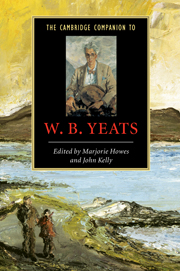Book contents
- Frontmatter
- 1 Introduction
- 2 Yeats and Romanticism
- 3 Yeats, Victorianism, and the 1890s
- 4 Yeats and Modernism
- 5 The later poetry
- 6 Yeats and the drama
- 7 Yeats and criticism
- 8 Yeats, folklore, and Irish legend
- 9 Yeats and the occult
- 10 Yeats and gender
- 11 Yeats and politics
- 12 Yeats and the postcolonial
- Bibliography
- Index
3 - Yeats, Victorianism, and the 1890s
Published online by Cambridge University Press: 28 January 2007
- Frontmatter
- 1 Introduction
- 2 Yeats and Romanticism
- 3 Yeats, Victorianism, and the 1890s
- 4 Yeats and Modernism
- 5 The later poetry
- 6 Yeats and the drama
- 7 Yeats and criticism
- 8 Yeats, folklore, and Irish legend
- 9 Yeats and the occult
- 10 Yeats and gender
- 11 Yeats and politics
- 12 Yeats and the postcolonial
- Bibliography
- Index
Summary
Yeats was in a literal sense a Victorian. Born in 1865 in what may be called the high noon of the Victorian period, he lived thirty-six of his seventy-four years “in the great peace of Queen Victoria and amid all the social and spiritual conditions prevailing through her realms.” One would not, however, find too many critics ready to characterize Yeats as a Victorian - indeed, that Yeats was irredeemably hostile to everything Victorian has been an article of critical faith. His own comments are pungent. His best known assault on qualities that he associated with Victorian poetry comes in the sprightly, controversial introduction to The Oxford Book of Modern Verse (1936), where he condemns its irrelevant descriptions of nature, its scientific and moral discursiveness, along with “the political eloquence of Swinburne, the psychological curiosity of Browning, and the poetical diction of everybody” (LE 183). Then, after describing the late Victorian poets of the nineties, many of whom he knew well and who tried to define themselves in revolt against what may be called mainstream Victorian aesthetic and moral positions, Yeats goes on: “Then in 1900 everybody got down off his stilts; henceforth nobody drank absinthe with his black coffee; nobody went mad; nobody committed suicide; nobody joined the Catholic church; or if they did I have forgotten . . . Victorianism had been defeated” (LE 185). If “Victorianism” had been defeated, the battle with it had been a vigorous one, and had shaped Yeats's sensibility in profound ways. The impact has been seen mainly as negative, as taking the form of rejection, but it is more complicated than that. Yeats owed more than he cared to admit to Matthew Arnold, and it is during the years up to 1901 that he forged his aesthetic philosophy. Yeats in part created or constructed his version of Victorianism, and in creating it and living it, in grappling with the substance as well as the shadow of the Victorian age, he forged lifelong aesthetic and philosophical positions.
- Type
- Chapter
- Information
- The Cambridge Companion to W. B. Yeats , pp. 36 - 58Publisher: Cambridge University PressPrint publication year: 2006
- 15
- Cited by



